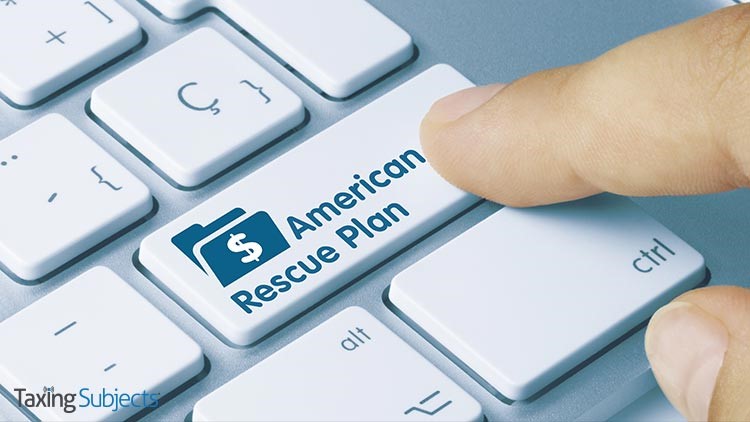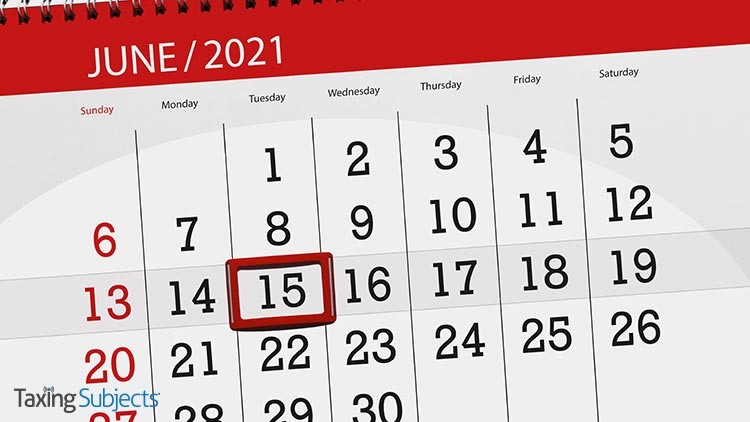by Socheata Ten EA, LLC | Jun 12, 2021 | Tax Tips and News
The Internal Revenue Service says it sent out millions of additional American Rescue Plan (ARP) payments to taxpayers in just a two-week period, pushing the total number of payments issued under the new law to just under 170 million.
The IRS teams with the Department of the Treasury and the Bureau of the Fiscal Service to send out the Economic Impact Payments (EIPs). The three agencies say some $395 billion has been distributed since the ARP payments started on March 12.
The effort, designed to keep the American economy going and recover through the course of the COVID-19 pandemic, has generated impressive numbers to date:
- In total, this latest round includes more than 2.3 million payments with a value of more than $4.2 billion.
- More than 900,000 payments, with a value of approximately $1.9 billion, went to eligible individuals for whom the IRS previously did not have information to issue an Economic Impact Payment but who recently filed a tax return.
- This also includes additional ongoing supplemental payments for people who earlier this year received payments based on their 2019 tax returns but are eligible for a new or larger payment based on their recently processed 2020 tax returns. In the last two weeks, there were more than 1.1 million of these “plus-up” payments, with a value of more than $2.5 billion. In all, the IRS has made more than 8 million of these supplemental payments this year.
- Overall, the last two weeks of payments contain more than 1.2 million direct deposit payments (with a total value over $2.2 billion) with the remainder as paper check payments.
The IRS notes that more Economic Impact Payments are being sent out weekly. Payments continue to be sent to those who didn’t previously have information with the IRS, but recently filed a tax return, and to those who qualify for “plus-up” payments.
Filing opens the door to EIPs
For most Americans, getting an Economic Impact Payment was an automatic event; because they had filed an income tax return, the IRS had the information necessary to get an EIP to them quickly and accurately.
That said, there are a significant number of people who haven’t filed a tax return in years and so are “under the radar” to get any of the government payments they might otherwise qualify for.
By not connecting with the IRS, these individuals may be missing out on benefits such as the 2020 Recovery Rebate Credit, the Child Tax Credit or the Earned Income Tax Credit.
Filing a 2020 return – even if the filer traditionally doesn’t need to file – can help the IRS determine if the person is qualified for EIPs and other tax benefits and give the agency contact information to help get the payment to the filer.
This summer, the IRS will add another reason for non-filers to send in a return: advance payments of the 2021 Child Tax Credit will start to go out, based on information in a 2020 return.
Filing also gives the IRS information it needs to send out payments for a qualifying dependent.
Individuals who don’t get federal benefits and don’t have an obligation to file a tax return still need to file so they can qualify for Economic Impact Payments. This includes those who are experiencing homelessness and others.
Those who didn’t get one of the earlier Economic Impact Payments—or got less than the full amounts—could qualify for the 2020 Recovery Rebate Credit, but will have to file a 2020 tax return to get the credit.
Go to the special section on IRS.gov, Claiming the 2020 Recovery Rebate Credit if you aren’t required to file a tax return, for more information.
The qualifying income levels are different for EIP3
It should be noted that the top qualifying income levels have been changed for the third round of Economic Impact Payments. This means some people won’t qualify for the latest EIP even if they received one of the earlier payments or claimed the 2020 Recovery Rebate Credit.
Taxpayers making $75,000 or above in Adjusted Gross Income (or $150,000 for married couples filing jointly) will see their EIPs reduced. The phase-out is complete for taxpayers who make more than $80,000 ($160,000 for married filing jointly). Those who make more won’t qualify for the EIP.
More information on Economic Impact Payments is available on IRS.gov. The Get My Payment tool can show the status of payments.
Source: More than 2.3 million additional Economic Impact Payments disbursed under the American Rescue Plan; total payments top 169 million.
– Story provided by TaxingSubjects.com
by Socheata Ten EA, LLC | Jun 10, 2021 | Tax Tips and News
Congress has passed a number of coronavirus relief packages throughout the pandemic. While the three rounds of Economic Impact Payments are the most famous provision of those legislative efforts, they were technically an advance on the new Recovery Rebate Credit.
Signed into law earlier this year, the American Rescue Plan Act of 2021 (ARPA) authorizes a lot of the same relief found in previous legislation. But one change has prompted the Internal Revenue Service to this week begin sending more than 36 million letters to potentially eligible taxpayers: The upcoming Advance Child Tax Credit monthly payments.
Who will receive a letter about the Advance Child Tax Credit from the IRS?
The Advance Child Tax Credit letters are being sent to three groups to ensure as many eligible taxpayers as possible receive their payments:
- Taxpayers who filed a tax year 2019 return
- Taxpayers who filed a tax year 2020 return
- Taxpayers who registered for an EIP using the Non-Filers: Enter Payment Info Here Tool
If the IRS determines that any recipients of the first letter are indeed eligible for Advance Child Tax Credit payments, those taxpayers “will receive a second, personalized letter listing an estimate of their monthly payment, which begins July 15.”
How do taxpayers qualify for the Advance Child Tax Credit?
Taxpayers must first qualify for the 2021 Child Tax Credit to receive advance payments. Under the previous law, only children 16 and younger were eligible, the maximum allowable credit was $2,000, and only $1,400 was refundable. For tax year 2021, children who are 17 and younger now qualify for the credit, the maximum allowable credit is increased based on the age of each qualifying dependent, and the entire credit is refundable.
The new maximum allowable amounts for the Child Tax Credit are:
To qualify for the maximum allowable credit for each qualifying child, eligible taxpayers must have a modified adjusted gross income (MAGI) below the following thresholds:
- $75,000 or less for singles
- $112,500 or less for heads of household
- $150,000 or less for married couples filing a joint return and qualified widows and widowers
The IRS explains that the amount of the credit begins to phase out when a taxpayer’s MAGI exceeds these thresholds: “The extra amount above the original $2,000 credit—either $1,000 or $1,600 per child—reduced by $50 for every extra $1,000 in modified AGI.”
If the Advance Child Tax Credit is being paid this year, what tax year is the IRS using to determine eligibility?
Normally, eligibility for a tax credit is determined using information from that tax year’s return, which is then filed by April 15 the following year (pandemics notwithstanding). Since the Advance Child Tax Credit payments will be made this year, the IRS has to determine eligibility using prior tax information: tax year 2019 or 2020 tax returns, whichever is most recent.
If that sounds familiar, it’s because the agency used a similar method to quickly distribute EIP funds. The good news is that most qualifying taxpayers who filed their 2020 return don’t have to do anything else to receive their advance payments. The bad news is this approach can result in eligible non-filers not receiving advance payments—prompting the following caveat in this week’s press release:
“The IRS urges individuals and families who haven’t yet filed their 2020 return—or 2019 return—to do so as soon as possible so they can receive any advance payment they’re eligible for. Filing soon will also ensure that the IRS has their most current banking information, as well as key details about qualifying children. This includes people who don’t normally file a tax return, such as families experiencing homelessness, the rural poor, and other underserved groups.”
How much will the Advance Child Tax Credit payments be worth?
The Advance Child Tax Credit payments are worth up to half of the total credit, capping out at a monthly payment of $300 for each qualifying child under 6 and $250 for all other qualifying child dependents.
When will the Advance Child Tax Credit payments be sent?
Advance Child Tax Credit payments will be made on the following days this year:
- July 15, 2021
- August 13, 2021
- September 15, 2021
- October 15, 2021
- November 15, 2021
- December 15, 2021
Reminder: The IRS will use whichever payment method was chosen by each qualifying taxpayer on their most recent return, whether direct deposit or physical check.
Where can taxpayers find more information about the Advance Child Tax Credit?
More information about the Advance Child Tax Credit can be found at IRS.gov/ChildTaxCredit2021. The agency notes this page will soon host links to two special online resources:
- An interactive Child Tax Credit eligibility tool to help families determine whether they qualify for the Advance Child Tax Credit payments.
- Another tool, the Child Tax Credit Update Portal, will initially enable anyone who has been determined to be eligible for advance payments unenroll/ to opt out of the advance payment program. Later this year, it will allow people to check on the status of their payments, make updates to their information, and be available in Spanish. More details will be available soon about the online Child Tax Credit Update Portal.
Source: IR-2021-124
– Story provided by TaxingSubjects.com
by Socheata Ten EA, LLC | Jun 9, 2021 | Tax Tips and News
It may seem that we just got through with the 2021 income tax season, but there’s already another tax deadline waiting in the wings. The Internal Revenue Service is reminding taxpayers who pay estimated taxes about their second-quarter installment deadline: June 15.
People generally pay estimated taxes when they have income that isn’t normally subject to withholding. The taxpayer may have income from self-employment, interest, dividends, rent, gains from a sale of assets, prizes, or awards.
Some taxpayers also may have to pay estimated tax if the amount of income withheld from their regular income—whether it’s salary, pension, or some other source—just isn’t enough to avoid a tax bill of $1,000 or more when they file. That $1,000 threshold is the same for individuals and business taxpayers, such as sole proprietors, partners, and S corporation shareholders.
Corporations, on the other hand, usually make estimated tax payments “if they expect to owe $500 or more in tax when they file.” The IRS recommends that corporate filers consult Form 1120-W, Estimated Tax for Corporations, for more information.
There are special rules governing estimated tax payments for some specific groups of taxpayers, including farmers, fishermen, higher income taxpayers, casualty or disaster victims, taxpayers who are recently disabled, recent retirees, and individuals whose income is received unevenly during the year.
Individuals who aren’t filing a business return can go online to the IRS Interactive Tax Assistant to see if they’re required to pay estimated taxes. Form 1040-ES, Estimated Tax for Individuals, has a worksheet with details on who has to pay estimated tax.
More information for individuals can be found in Publication 505, Tax Withholding and Estimated Tax. This publication can be especially helpful to those who have dividend or capital gain income, owe alternative minimum tax or self-employment tax, or have some other special situation.
Avoid nasty tax-time surprises
The Internal Revenue Service views income taxes as a pay-as-you-go proposition. That means taxpayers should pay most of their taxes owed during the year as the income is received.
There are two ways to reach that goal:
- Withholding from pay, pension or government payments such as Social Security
- Making quarterly estimated tax payments during the year
When taxpayers don’t withhold enough from income to cover their tax bill, they can face an underpayment penalty from the IRS. The way to avoid this is to either owe less than $1,000 at tax time, or to pay most of the tax bill during the year.
For this year, that means taxpayers should be making payments of at least 90 percent of the tax they expect on their 2021 return. Most taxpayers who pay at least 100 percent of the tax on their tax year 2020 return may also avoid a penalty.
Here again, some special rules exist for certain groups of taxpayers. For more information, check out Form 1040-ES, Estimated Tax for Individuals.
In most cases, taxpayers make their estimated tax payments in four equal amounts, paid quarterly. However, if a taxpayer receives their income unevenly during the course of the year, they may be able to vary the amounts of their quarterly payments to lower their underpayment penalty or even avoid it altogether.
Form 2210, Underpayment of Estimated Tax by Individuals, Estates and Trusts, can show taxpayers if they owe a penalty for underpaying their estimated tax.
Third-quarter payments are due by September 15; fourth-quarter payments are due by Jan. 17, 2022.
Making adjustments …
Taxpayers who get salaries and wages can avoid having to pay estimated tax simply by asking their employer to withhold more taxes from their paychecks. This is done by submitting a new Form W-4 to the employer.
The IRS Tax Withholding Estimator can help taxpayers who receive a paycheck make sure they have the right amount of tax held out every pay period. This tool offers taxpayers a step-by-step method of checking their withholding levels so they can avoid an unexpected tax bill or penalty at tax time.
Form 1040-ES also has instructions to help taxpayers figure their estimated taxes.
Making payments …
Taxpayers looking to pay estimated taxes have some options. For speed and ease of use, the IRS recommends its Direct Pay service from the taxpayer’s checking or savings account. Another choice is to pay using a credit or debit card. Both options are available online at IRS.gov and through the IRS2go app.
Note, however, that the payment processor—not the IRS—charges a fee for debit and credit card payments.
A third option is to use the Electronic Federal Tax Payment System (EFTPS) to make an estimated tax payment.
Corporations have to use electronic funds transfer to make all federal tax deposits, including installment payments of estimated tax. Generally, this is done through the EFTPS, but if the corporation wants a different option, it can arrange for its tax professional, financial institution, payroll service or other trusted third party to make electronic deposits on its behalf.
Visit IRS.gov/payments for more information on all payment options.
Source: IR-2021-125
– Story provided by TaxingSubjects.com
by Socheata Ten EA, LLC | Jun 8, 2021 | Tax Tips and News
Millions of Americans paid taxes on their unemployment compensation before learning that an exclusion was introduced by legislation a month into filing season. So, the Internal Revenue Service is now sending some of those taxpayers a refund to satisfy the new law.
Some 13 million taxpayers could be eligible for the adjustment. The IRS says the refund is an effort to spare those taxpayers from the hassle of filing an amended tax return. Not all of those taxpayers will actually see their refund per se; the IRS says some refunds will be used to pay tax due or other debts, while other taxpayers won’t see a change at all.
So far, the IRS has checked just over 3 million returns, with more than 2.8 million taxpayers getting a refund.
The change applies to TY 2020
“The American Rescue Plan Act of 2021 (ARP) excluded up to $10,200 in unemployment compensation per taxpayer paid in 2020,” the IRS explains. “The $10,200 is the maximum amount that can be excluded when calculating taxable income; it is not the amount of refunds.”
The IRS says that it began reviewing returns that were “filed prior to the enactment of ARPA to identify the excludible unemployment compensation.” As a result, the reviews are also checking for any changes in the Earned Income Tax Credit (EITC), Premium Tax Credit, or Recovery Rebate Credit that would result from the exclusion.
Despite the IRS’ effort to save taxpayers the trouble of amending their return, some people will have to do just that to get their benefits. For example, taxpayers who have qualifying children and become eligible for the EITC after the exclusion is calculated may have to file an amended return to claim their new benefits.
The IRS says it can adjust tax returns where the taxpayer is single with no children and becomes eligible for the EITC, as well as those returns where EITC was claimed and the qualifying children have been identified.
The refunds will continue
These unemployment exclusion-related refunds will be sent out periodically, with more due out in a few weeks. The cycle of review-and-refund will continue through the summer; the IRS is working the simplest returns first and progressing on to more complex tax returns as the process progresses.
Further, the IRS says it is sending letters to taxpayers who get an adjustment to let them know they’ll receive a refund—or that their adjustment is being used to pay a tax debt or some other type of authorized debt.
The agency says the letters are generally sent within 30 days of the adjustment.
Source: IR-2021-123
– Story provided by TaxingSubjects.com
by Socheata Ten EA, LLC | Jun 5, 2021 | Tax Tips and News
By most measures, 2021 is shaping up to be much better than 2020. The coronavirus appears to be less of a threat, the economy is beginning a comeback, and the American Rescue Plan is expanding some tax credits for parents and others with children.
The American Rescue Plan (ARP) was passed by Congress earlier this year. The new law sent out direct Economic Impact Payments to millions of Americans. But it also changed tax laws for 2021—and beyond.
Earned Income Tax Credit (EITC)
The EITC has been a workhorse tax credit for some time now, providing working families with a needed tax break. The ARP expands the credit, so more workers and working families who also have investment income can qualify for the EITC.
Starting this year, qualified filers can receive up to $10,000 in investment income and still be eligible for the EITC. The new law also opens doors for separated spouses.
Those who are married but separated can now qualify for the EITC if they live with their qualifying child for more than half the year and can satisfy one of these two requirements:
- The taxpayer doesn’t “have the same principal place of abode as the other spouse for at least the last six months of tax year for which the EITC is being claimed”
- The taxpayer is “legally separated according to their state law under a written separation agreement or a decree of separate maintenance and does not live in the same household as their spouse at the end of tax year for which the EITC is being claimed”
Child Tax Credit (CTC)
The Child Tax Credit saw four major changes that apply only for the 2021 tax year. The American Rescue Plan increased the amount of the credit and made the CTC available for qualifying children who turn age 17 in 2021.
But the ARP made two more changes that millions of families are likely to see firsthand. The CTC was also made fully refundable for most taxpayers and for the first time, qualified taxpayers will be able to get half of the estimated 2021 credit—in advance.
Those taxpayers with qualifying children under age 18 at the end of 2021 can now get the full credit even if they have little or no income.
Before this year, the credit was capped at $2,000 per qualifying child and was refundable up to $1,400 per child. The American Rescue Plan boosts the credit limit to $3,000 per child aged 6 through 17 at the end of 2021; the cap rises to $3,600 each for children age 5 and under at the end of 2021.
The ARP also expands the number of taxpayers who will get cold cash in their pockets from the Child Tax Credit. The credit is fully refundable for those who have their main homes in the U.S. for more than half the tax year. Bona fide residents of Puerto Rico enjoy the same privilege.
If a taxpayer qualifies for the fully refundable credit, the normal $1,400 cap does not apply. A taxpayer qualifies for the maximum credit if they have a modified adjusted gross income of:
- $75,000 or less for single filers and married persons filing separate returns
- $112,500 or less for heads of household
- $150,000 or less for married couples filing jointly and qualifying widows and widowers
Above these levels, the credit begins a phase-out.
Advance Child Tax Credit Payments
The IRS says it expects to send out advance payments of the Child Tax Credit from July 15 through December of this year. Eligible taxpayers will get half of their estimated 2021 CTC in monthly payments during that time.
The payments will go out to those taxpayers who qualify for the Child Tax Credit and have a main home in the U.S. for at least half of the year. This includes all 50 states and the District of Columbia. American military personnel who are stationed outside of the country on extended active duty are also eligible, since they are considered to have a main home in the United States.
“The monthly advance payments will be estimated from their 2020 tax return, or their 2019 tax return if 2020 information is not available,” the IRS explains. “Advance payments will not be reduced or offset for overdue taxes or other federal or state debts that taxpayers or their spouses owe.”
Since the advance payments amount to half of the tax credit, taxpayers can claim the remainder when they file their 2021 income tax return.
Source: Looking ahead: How the American Rescue Plan affects 2021 taxes
– Story provided by TaxingSubjects.com
by Socheata Ten EA, LLC | Jun 4, 2021 | Tax Tips and News
Uncle Sam is reminding its citizens who live and work outside its borders that their tax deadline is rapidly approaching.
While the bulk of taxpayers had to get their tax returns filed by May 17 this year, U.S. citizens and resident aliens who live abroad—as well as those with dual citizenship—have to file by June 15.
Just like their fellow citizens inside the U.S., those living abroad have to file a tax return with the IRS every year. They usually automatically get a two-month extension of time to file, putting the deadline this year at June 15.
Stateside taxpayers got an extension from April 15 to May 17, but foreign taxpayers didn’t receive another extension beyond the normal postponement.
Even if a foreign-based U.S. taxpayer doesn’t expect to owe tax thanks to tax benefits such as the Foreign Earned Income Exclusion or the Foreign Tax Credit, they’re still required to file an income tax return by the deadline. The tax benefits are only available if they file a return.
The Internal Revenue Service says taxpayers claiming the special June 15 deadline should attach a statement to their return if one of two conditions apply:
- The taxpayer’s tax home and abode are both outside the U.S. and Puerto Rico, or
- The taxpayer was serving in the American military outside the U.S. and Puerto Rico on the regular due date for the return.
Even with the prior extension of time, some taxpayers may not be able to get their return in on time. Individual taxpayers who need more time to file can complete and mail Form 4868, Application for Automatic Extension of Time to File U.S. Individual Income Tax Return. Click here to find out where to mail the form.
Businesses that have to file income tax returns should file Form 7004, Application for Automatic Extension of Time To File Certain Business Income Tax, Information, and Other Returns.
Report foreign accounts and other assets
An important part of filing for foreign-based income tax filers is reporting any worldwide income to the IRS. This can include income from foreign trusts and foreign bank or securities accounts.
Taxpayers with this kind of income will generally have to include Schedule B to their tax return. Schedule B’s Part III asks the taxpayer for information on any foreign accounts, and requires the taxpayer to report the country where each account is located.
Some taxpayers may also have to include Form 8938, Statement of Foreign Financial Assets. U.S. citizens, resident aliens and some nonresident aliens usually have to report specified foreign financial assets on this form if the total value of those assets are above certain limits. For details, see the directions for Form 8938.
Another layer of reporting is required for taxpayers who have either an interest in, or signature or other authority over foreign financial accounts with a total value of more than $10,000 at any time during 2020. These taxpayers must electronically file a Financial Crimes Enforcement Network (FinCEN) Form 114, Report of Foreign Bank and Financial Accounts with the Treasury Department.
Form 114 is only available through the BSA E-filing System website.
While the original deadline for filing the annual FBAR report was April 15, FinCEN gives those who missed the deadline an automatic extension until Oct. 15 to file. There’s no need to request the extension.
Foreign-based filers should remember that when reporting income or deductible expenses, the amounts must be reported in U.S. dollars.
FinCEN Form 114 and IRS Form 8938 both require the use of a December 31 exchange rate for all transactions regardless of the actual rate on the date of the transaction.
For information on exchange rates, refer to Foreign Currency and Currency Exchange Rates.
Reporting for expats
Those taxpayers who gave up their U.S. citizenship or ceased to be lawful permanent residents of the U.S. during 2020 have to file a dual-status alien tax return, attaching Form 8854, Initial and Annual Expatriation Statement.
A copy of Form 8854 should also be mailed to this IRS address:
Internal Revenue Service
3651 S IH35 MS 4301AUSC
Austin, TX 78741
The form should be mailed by the due date of the tax return, including any extensions.
For more information, see the instructions for Form 8854 and Notice 2009-85, Guidance for Expatriates Under Section 877A.
More time for some members of the military
Members of the American military can qualify for even more time to file and pay their taxes. If either of these two conditions apply, they can get an additional extension of 180 days to file and pay any tax due:
- They serve in a combat zone or have qualifying service outside of a combat zone or
- They serve on deployment outside the United States away from their permanent duty station while participating in a contingency operation. This is a military operation designated by the Secretary of Defense or results in calling members of the uniformed services to active duty (or retains them on active duty) during a war or a national emergency declared by the President or Congress.
Individuals serving in a combat zone or a contingency operation in support of the Armed Forces are also granted extended deadlines. This includes Red Cross personnel, accredited reporters and civilian personnel acting under the direction of the Armed Forces in support of their forces.
Spouses of those who served in a combat zone or a contingency operation generally are entitled to the same deadline extensions, however, some exceptions apply. Details and other military tax information is available in IRS Publication 3, Armed Forces’ Tax Guide.
More information for foreign-based filers may be found in About Publication 54, Tax Guide for U.S. Citizens and Resident Aliens Abroad; and About Publication 519, U.S. Tax Guide for Aliens.
– Story provided by TaxingSubjects.com







 Socheata Ten EA, LLC
Socheata Ten EA, LLC